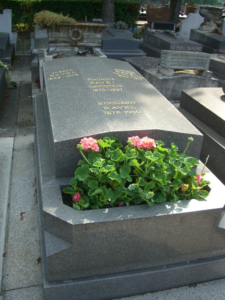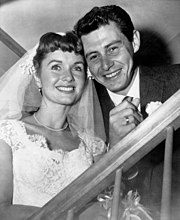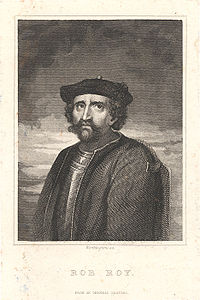 On this day in 1734, Scottish folk hero, cattleman, outlaw, the Scottish Robin Hood, Red MacGregor, Rob Roy, died at his house in Inverlochlarig Beg, Balquhidder, Scotland, at the age of 63. Born Robert Roy MacGregor at Glengyle, Scotland at the age of 63. Baptised 7 March 1671. Rob Roy is anglicised from the Scottish Gaelic Raibeart Ruadh, or Red Robert. This is because Rob Roy had red hair, though it darkened to auburn in later life. His father was Donald MacGregor, and his mother Margaret Campbell. He later met Mary Helen MacGregor of Comar, who was born at Leny Farm, Strathyre, and they were married in Glenarklet in January 1693. She bore him four sons: James (known as Mor or Tall), Ranald, Coll, and Robert (known as Robin Oig or Young Rob). Rob Roy together with his father joined the Jacobite rising led by Viscount Dundee, Bonnie Dundee, to support the Stuart King James who had been deposed by William of Orange.
On this day in 1734, Scottish folk hero, cattleman, outlaw, the Scottish Robin Hood, Red MacGregor, Rob Roy, died at his house in Inverlochlarig Beg, Balquhidder, Scotland, at the age of 63. Born Robert Roy MacGregor at Glengyle, Scotland at the age of 63. Baptised 7 March 1671. Rob Roy is anglicised from the Scottish Gaelic Raibeart Ruadh, or Red Robert. This is because Rob Roy had red hair, though it darkened to auburn in later life. His father was Donald MacGregor, and his mother Margaret Campbell. He later met Mary Helen MacGregor of Comar, who was born at Leny Farm, Strathyre, and they were married in Glenarklet in January 1693. She bore him four sons: James (known as Mor or Tall), Ranald, Coll, and Robert (known as Robin Oig or Young Rob). Rob Roy together with his father joined the Jacobite rising led by Viscount Dundee, Bonnie Dundee, to support the Stuart King James who had been deposed by William of Orange. 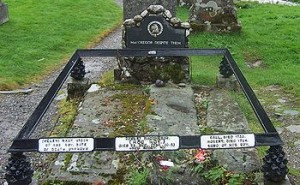
The Final Footprint – Rob Roy is interred with his wife and sons Coll and Robert in Balquhidder Church Cemetery, Balquhidder, Scotland. Their graves are enclosed by an ornamental bronze rail and marked by an upright stone marker with the inscription; MACGREGOR DESPITE THEM. The publication of Rob Roy, by Sir Walter Scott in 1817, further added to his fame and fleshed out his biography. William Wordsworth wrote a poem called “Rob Roy’s Grave” during a visit to Scotland. Adaptations of his story has also been told in film, including the 1995 Rob Roy directed by Michael Caton-Jones and starring Liam Neeson.
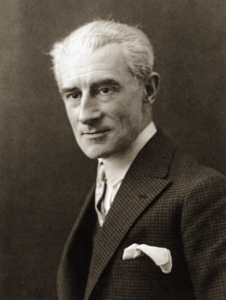 On this day in 1937, composer, pianist and conductor Maurice Ravel died in Paris at the age of 62. Born Joseph Maurice Ravel on 7 March 1875 in the Basque town of Ciboure, France, near Biarritz. He is often associated with impressionism along with his elder contemporary Claude Debussy, although both composers rejected the term. In the 1920s and 1930s Ravel was internationally regarded as France’s greatest living composer.
On this day in 1937, composer, pianist and conductor Maurice Ravel died in Paris at the age of 62. Born Joseph Maurice Ravel on 7 March 1875 in the Basque town of Ciboure, France, near Biarritz. He is often associated with impressionism along with his elder contemporary Claude Debussy, although both composers rejected the term. In the 1920s and 1930s Ravel was internationally regarded as France’s greatest living composer.
Born to a music-loving family, Ravel attended France’s premier music college, the Paris Conservatoire; he was not well regarded by its conservative establishment, whose biased treatment of him caused a scandal. After leaving the conservatoire, Ravel found his own way as a composer, developing a style of great clarity and incorporating elements of modernism, baroque, neoclassicism and, in his later works, jazz. He liked to experiment with musical form, as in his best-known work, Boléro (1928), in which repetition takes the place of development. He made some orchestral arrangements of other composers’ music, of which his 1922 version of Mussorgsky’s Pictures at an Exhibition is the best known.
A slow and painstaking worker, Ravel composed fewer pieces than many of his contemporaries. Among his works to enter the repertoire are pieces for piano, chamber music, two piano concertos, ballet music, two operas and eight song cycles; he wrote no symphonies or church music. Many of his works exist in two versions: first, a piano score and later an orchestration. Some of his piano music, such as Gaspard de la nuit (1908), is exceptionally difficult to play, and his complex orchestral works such as Daphnis et Chloé (1912) require skilful balance in performance.
The Final Footprint
On 30 December 1937 Ravel was interred next to his parents in a granite tomb at Levallois-Perret cemetery, in north-west Paris. He was an atheist and there was no religious ceremony.
#RIP #OTD in 1938 stage performer, film actress, the “Biograph Girl”, “the first movie star”, Florence Lawrence died from ingesting ant poison and cough syrup at her home in West Hollywood, aged 52. Hollywood Forever Cemetery
#RIP #OTD in 1983 musician, singer, songwriter (“Little Bird”, “Forever”, “Farewell My Friend”) co-founder of the Beach Boys, Dennis Wilson drowned at Marina Del Rey, California, aged 39. Buried at sea by the US Coast Guard off the coast of California
#RIP #OTD in 1984 director, screenwriter (The Wild Bunch, Straw Dogs, Junior Bonner, The Getaway, Pat Garrett and Billy the Kid, Bring Me the Head of Alfredo Garcia,) Sam Peckinpah died of a heart attack in Inglewood CA, aged 59. Cremated remains scattered off the coast of Malibu
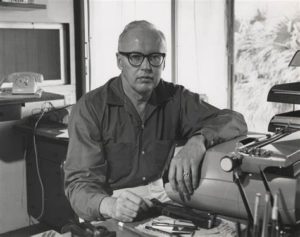 On this day in 1986, writer of novels and short stories John D. MacDonald died following complications of coronary artery bypass surgery in St. Mary’s Hospital in Milwaukee, Wisconsin, at the age of 70. Born John Dann MacDonald on July 24, 1916 in Sharon, Pennsylvania. MacDonald was a prolific author of crime and suspense novels, many of them set in his adopted home of Florida. Perhaps best known for his popular and critically acclaimed Travis McGee series, and his 1957 novel The Executioners, which was filmed as Cape Fear (1962) and remade in 1991.
On this day in 1986, writer of novels and short stories John D. MacDonald died following complications of coronary artery bypass surgery in St. Mary’s Hospital in Milwaukee, Wisconsin, at the age of 70. Born John Dann MacDonald on July 24, 1916 in Sharon, Pennsylvania. MacDonald was a prolific author of crime and suspense novels, many of them set in his adopted home of Florida. Perhaps best known for his popular and critically acclaimed Travis McGee series, and his 1957 novel The Executioners, which was filmed as Cape Fear (1962) and remade in 1991.
In 1972, the Mystery Writers of America bestowed upon MacDonald its highest honor, the Grand Master Award for lifetime achievement and consistent quality. Stephen King praised MacDonald as “the great entertainer of our age, and a mesmerizing storyteller.” Kingsley Amis said, MacDonald “is by any standards a better writer than Saul Bellow, only MacDonald writes thrillers and Bellow is a human-heart chap, so guess who wears the top-grade laurels.”
MacDonald’s protagonists were often intelligent, introspective, and (sometimes) cynical men. Travis McGee, the “salvage consultant” and “knight-errant,” was all of that. McGee made his living by recovering the loot from thefts and swindles, keeping half to finance his “retirement,” which he took in segments as he went along. He first appeared in the 1964 novel The Deep Blue Good-by and starred in 21 novels through to the series’ final release, 1985’s The Lonely Silver Rain. All titles in the series include a color, a mnemonic device which was suggested by his publisher so that when harried travelers in airports looked to buy a book, they could at once see those MacDonald titles they had not yet read.
The McGee novels feature an ever-changing array of female companions; some particularly nasty villains; exotic locales in Florida, Mexico, and the Caribbean; and appearances by a sidekick known only as “Meyer,” an economist of international renown and a Ph.D. As Sherlock Holmes had his well-known address on Baker Street, McGee had his lodgings on his 52-foot (16 m) houseboat, the Busted Flush, named for the poker hand that started the run of luck which enabled him to win the boat. She is docked at Slip F-18, marina Bahia Mar, Fort Lauderdale, Florida.
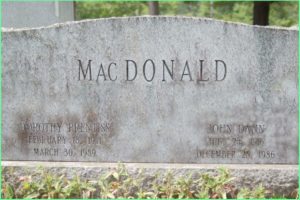 The Final Footprint
The Final Footprint
He is buried in Milwaukee, at Holy Cross Cemetery and Mausoleum. He was survived by his wife Dorothy (1911-1989) and a son, Maynard.
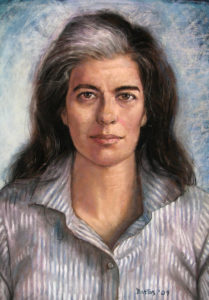 On this day in 2004, writer, filmmaker, philosopher, teacher, and political activist Susan Sontag died from complications of myelodysplastic syndrome in New York City, at the age of 71. Born Susan Rosenblatt in New York City on January 16, 1933. She mostly wrote essays, but also published novels; she published her first major work, the essay “Notes on ‘Camp'”, in 1964. Perhaps her best-known works include On Photography, Against Interpretation, Styles of Radical Will, The Way We Live Now, Illness as Metaphor, Regarding the Pain of Others, The Volcano Lover, and In America.
On this day in 2004, writer, filmmaker, philosopher, teacher, and political activist Susan Sontag died from complications of myelodysplastic syndrome in New York City, at the age of 71. Born Susan Rosenblatt in New York City on January 16, 1933. She mostly wrote essays, but also published novels; she published her first major work, the essay “Notes on ‘Camp'”, in 1964. Perhaps her best-known works include On Photography, Against Interpretation, Styles of Radical Will, The Way We Live Now, Illness as Metaphor, Regarding the Pain of Others, The Volcano Lover, and In America.
Sontag was active in writing and speaking about, or travelling to, areas of conflict, including during the Vietnam War and the Siege of Sarajevo. She wrote extensively about photography, culture and media, AIDS and illness, human rights, and communism and leftist ideology. Although her essays and speeches sometimes drew controversy, in my opinion, she was one of the most influential critics of her generation.
Sontag lived with the writer and model Harriet Sohmers Zwerling whom she first met at U. C. Berkeley from 1958 to 1959. Afterwards, Sontag was the partner of María Irene Fornés, a Cuban-American avant garde playwright and director. Upon splitting with Fornés, she was involved with an Italian aristocrat, Carlotta Del Pezzo, and the German academic Eva Kollisch. Sontag was romantically involved with the American artists Jasper Johns and Paul Thek. During the early 1970s, Sontag lived with Nicole Stéphane, a Rothschild banking heiress turned movie actress, and, later, the choreographer Lucinda Childs. She also had a relationship with the writer Joseph Brodsky. With Annie Leibovitz, Sontag maintained a relationship stretching from the later 1980s until her final years.
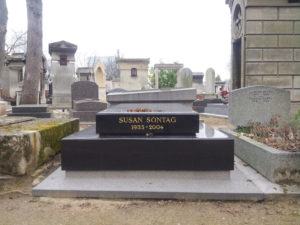 The Final Footprint
The Final Footprint
She is buried in Paris at Cimetière du Montparnasse. Other notable Final Footprints at Montparnasse include; Charles Baudelaire, Simone de Beauvoir, Samuel Beckett, Emmanuel Chabrier, César Franck, Guy de Maupassant, Adah Isaacs Menken, Man Ray, Camille Saint-Saëns, Jean-Paul Sartre, and Jean Seberg.
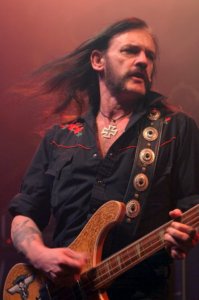 On this day in 2015, musician, singer-songwriter, founder and frontman for Motörhead, Lemmy died at his apartment in Los Angeles at 4pm PST, from prostate cancer, congestive heart failure, and cardiac arrhythmia at the age of 70. Born Ian Fraser Kilmister on 24 December 1945 in Stoke-on-Trent, Staffordshire, England, United Kingdom. In my opinion, their music was one of the foundations of the heavy metal genre. He was known for his appearance (including his friendly mutton chops), and his distinctive gravelly, raspy singing voice. He was also known for his unmistakable bass playing style, using a Rickenbacker bass and over-driven Marshall tube bass stacks. Alongside his music career, he also had many minor roles and cameo appearances in film and television.
On this day in 2015, musician, singer-songwriter, founder and frontman for Motörhead, Lemmy died at his apartment in Los Angeles at 4pm PST, from prostate cancer, congestive heart failure, and cardiac arrhythmia at the age of 70. Born Ian Fraser Kilmister on 24 December 1945 in Stoke-on-Trent, Staffordshire, England, United Kingdom. In my opinion, their music was one of the foundations of the heavy metal genre. He was known for his appearance (including his friendly mutton chops), and his distinctive gravelly, raspy singing voice. He was also known for his unmistakable bass playing style, using a Rickenbacker bass and over-driven Marshall tube bass stacks. Alongside his music career, he also had many minor roles and cameo appearances in film and television.
He played in several rock groups in the 1960s, including the Rockin’ Vickers. He worked as a roadie for Jimi Hendrix and The Nice, before joining the space rock band Hawkwind in 1971, singing lead vocals on their hit “Silver Machine”. After being fired from Hawkwind for drug possession in 1975, he founded Motörhead during the same year as the lead singer, bassist, songwriter and frontman. Motörhead’s success peaked in 1980 and 1981 and included the hit single “Ace of Spades” and the top charting live album No Sleep ’til Hammersmith. Lemmy continued to record and tour regularly with Motörhead until his death.
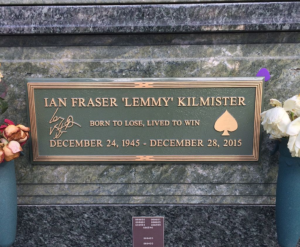 The Final Footprint
The Final Footprint
Lemmy’s memorial service took place at Forest Lawn Memorial Park, Hollywood Hills, on 9 January 2016. The service was streamed live over YouTube with more than 230,000 people logging on to watch, while others gathered at the Rainbow Bar and Grill. His body was cremated following the funeral. His remains were placed in a 3D-printed mantelpiece shaped like his trademark cavalry hat and emblazoned with the slogan “born to lose, lived to win”. The piece was on display during his funeral and was later interred at Forest Lawn. Other notable final footprints at Hollywood Hills include; Gene Autry, Albert “Cubby” Broccoli, David Carradine, Scatman Crothers, Bette Davis, Sandra Dee, Ronnie James Dio, Michael Clarke Duncan, Carrie Fisher, Bobby Fuller, Andy Gibb, Michael Hutchence, Jill Ireland, Al Jarreau, Buster Keaton, Jack LaLanne, Nicolette Larson, Liberace, Strother Martin, Jayne Meadows, Brittany Murphy, Ricky Nelson, Bill Paxton, Brock Peters, Freddie Prinze, Lou Rawls, Debbie Reynolds, Telly Savalas, Lee Van Cleef, and Paul Walker.
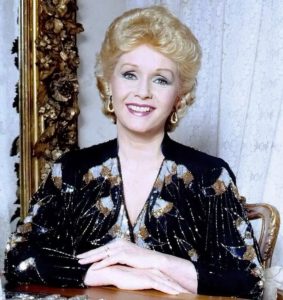 On this day in 2016, actress, singer, businesswoman, film historian, and humanitarian Debbie Reynolds died the day after her daughter Carrie Fisher, from a stroke at Cedars-Sinai Medical Center in Los Angeles at the age of 84. Born Mary Frances Reynolds on April 1, 1932 in El Paso, Texas. With a career spanning almost 70 years, She was nominated for the Golden Globe Award for Most Promising Newcomer for her portrayal of Helen Kane in the 1950 film Three Little Words, and her breakout role was her first leading role, as Kathy Selden in Singin’ in the Rain (1952). Other successes include The Affairs of Dobie Gillis (1953), Susan Slept Here (1954), Bundle of Joy (1956 Golden Globe nomination), The Catered Affair (1956 National Board of Review Best Supporting Actress Winner), and Tammy and the Bachelor (1957), in which her performance of the song “Tammy” reached number one on the Billboard music charts. In 1959, she released her first pop music album, titled Debbie.
On this day in 2016, actress, singer, businesswoman, film historian, and humanitarian Debbie Reynolds died the day after her daughter Carrie Fisher, from a stroke at Cedars-Sinai Medical Center in Los Angeles at the age of 84. Born Mary Frances Reynolds on April 1, 1932 in El Paso, Texas. With a career spanning almost 70 years, She was nominated for the Golden Globe Award for Most Promising Newcomer for her portrayal of Helen Kane in the 1950 film Three Little Words, and her breakout role was her first leading role, as Kathy Selden in Singin’ in the Rain (1952). Other successes include The Affairs of Dobie Gillis (1953), Susan Slept Here (1954), Bundle of Joy (1956 Golden Globe nomination), The Catered Affair (1956 National Board of Review Best Supporting Actress Winner), and Tammy and the Bachelor (1957), in which her performance of the song “Tammy” reached number one on the Billboard music charts. In 1959, she released her first pop music album, titled Debbie.
She starred in How the West Was Won (1962), and The Unsinkable Molly Brown (1964), a biographical film about the famously boisterous Molly Brown. Her performance as Brown earned her a nomination for the Academy Award for Best Actress. Her other films include The Singing Nun (1966), Divorce American Style (1967), What’s the Matter with Helen? (1971), Charlotte’s Web (1973), Mother (1996) (Golden Globe nomination), and In & Out (1997). Reynolds was also a cabaret performer. In 1979, she founded the Debbie Reynolds Dance Studio in North Hollywood, which still operates today.
In 1969, she starred on television in The Debbie Reynolds Show, for which she received a Golden Globe nomination. In 1973, Reynolds starred in a Broadway revival of the musical Irene and was nominated for the Tony Award for Best Lead Actress in a Musical. She was also nominated for a Daytime Emmy Award for her performance in A Gift of Love (1999) and an Emmy Award for playing Grace’s mother Bobbi on Will & Grace. At the turn of the millennium, Reynolds reached a new younger generation with her role as Aggie Cromwell in Disney’s Halloweentown series. In 1988, she released her autobiography, titled Debbie: My Life. In 2013, she released a second autobiography, Unsinkable: A Memoir.
Reynolds also owned a Las Vegas hotel and casino, and she was an avid collector of film memorabilia, beginning with items purchased at the landmark 1970 MGM auction. She served as president of The Thalians, an organization dedicated to mental health causes. Reynolds continued to perform successfully on stage, television, and film into her eighties. In January 2015, Reynolds received the Screen Actors Guild Life Achievement Award. In 2016, she received the Academy Awards Jean Hersholt Humanitarian Award. In the same year, a documentary about her life was released titled Bright Lights: Starring Carrie Fisher and Debbie Reynolds, which turned out to be her final film appearance; the film premiered on HBO on January 7, 2017.
Reynolds was married three times. Her first marriage was to singer Eddie Fisher in 1955. They became the parents of Carrie (1956–2016) and Todd Fisher (1958). The couple divorced in 1959 when it was revealed shortly after the death of Elizabeth Taylor‘s husband Mike Todd that Fisher had been having an affair with her. The affair was a great public scandal which led to the cancellation of Eddie Fisher’s television show.
Reynolds’ second marriage, to millionaire businessman Harry Karl, lasted from 1960 to 1973. For a period during the 1960s, she stopped working at the studio on Friday afternoons to attend Girl Scout meetings, since she was the leader of the Girl Scout Troop of which 13-year-old Carrie and her stepdaughter Tina Karl, also 13, were members. Reynolds later found herself in financial difficulty because of Karl’s gambling and bad investments. Reynolds’ third marriage was to real estate developer Richard Hamlett from 1984 to 1996.
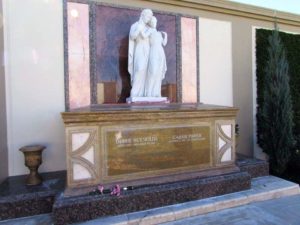 The Final Footprint
The Final Footprint
Her son Todd later said Reynolds had been seriously impacted by Carries’s death, and grief was partially responsible for her stroke, noting that his mother had stated “I want to be with Carrie” shortly before she died. He said his mother had joined his sister in death because Reynolds “didn’t want to leave Carrie and did not want her to be alone”. He added, “she didn’t die of a broken heart” as some news reports had implied, but rather “just left to be with Carrie”.
Reynolds was entombed while Carrie was cremated. A portion of Fisher’s ashes were laid to rest beside Reynolds’s crypt at Forest Lawn Memorial Park in Hollywood Hills, during a larger joint memorial service held on March 25, while the remainder of Carrie’s ashes are held in a giant, novelty Prozac pill. Other notable final footprints at Hollywood Hills include; Gene Autry, Albert “Cubby” Broccoli, David Carradine, Scatman Crothers, Bette Davis, Sandra Dee, Ronnie James Dio, Michael Clarke Duncan, Carrie Fisher, Bobby Fuller, Andy Gibb, Michael Hutchence, Jill Ireland, Al Jarreau, Buster Keaton, Lemmy Kilmister, Jack LaLanne, Nicolette Larson, Liberace, Strother Martin, Jayne Meadows, Brittany Murphy, Ricky Nelson, Bill Paxton, Brock Peters, Freddie Prinze, Lou Rawls, Telly Savalas, Lee Van Cleef, and Paul Walker.
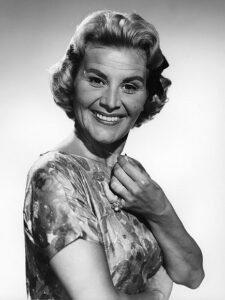 On this day in 2017 actress, singer, comedian, and vaudeville performer with a career ultimately spanning nine decades, which included film, radio, records, theater, night clubs and television, Rose Marie died at her home in the Van Nuys neighborhood of Los Angeles at the age of 94 . Born Rose Marie Mazzetta in Manhattan, New York, on August 15, 1923.
On this day in 2017 actress, singer, comedian, and vaudeville performer with a career ultimately spanning nine decades, which included film, radio, records, theater, night clubs and television, Rose Marie died at her home in the Van Nuys neighborhood of Los Angeles at the age of 94 . Born Rose Marie Mazzetta in Manhattan, New York, on August 15, 1923.
As a child performer during the years just after the silent film era, she had a successful singing career under the stage name Baby Rose Marie. was widely known for her role on the CBS situation comedy The Dick Van Dyke Show (1961–1966), as television comedy writer Sally Rogers, “who went toe-to-toe in a man’s world”.[2] Later, she portrayed Myrna Gibbons on The Doris Day Show and was a featured celebrity on The Hollywood Squares for 14 years.
She is the subject of a 2017 documentary film, Wait for Your Laugh, which includes interviews with her and her co-stars including Carl Reiner, Dick Van Dyke, Peter Marshall, and Tim Conway.
Marie was memorialized as “the patron saint of female comedy writers”. Marie’s long-time friend and agent, Harlan Boll, says that the legendary actress’s death had to do with “age problems.” Boll was with Marie shortly before she passed away. He explained to reporters that Marie had laid down to rest on Thursday afternoon, and by the time her caregiver checked in on her, to see if she wanted something to eat, and discovered she had stopped breathing.”
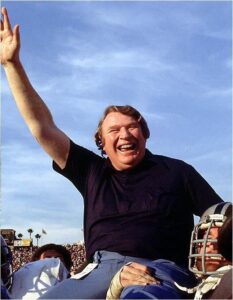 And on this day in 2021, American football coach and sports commentator in the National Football League (NFL) John Madden died in Pleasanton, California, aged 85. Born John Earl Madden in Austin, Minnesota on April 10, 1936.
And on this day in 2021, American football coach and sports commentator in the National Football League (NFL) John Madden died in Pleasanton, California, aged 85. Born John Earl Madden in Austin, Minnesota on April 10, 1936.
He served as the head coach of the Oakland Raiders from 1969 to 1978, who he led to eight playoff appearances, seven division titles, seven AFL / AFC Championship Game appearances, and the franchise’s first Super Bowl title in Super Bowl XI. Never having a losing season, Madden holds the highest winning percentage among NFL head coaches who coached 100 games.
After retiring from coaching, Madden was a color commentator for NFL telecasts from 1979 to 2008, which earned him 16 Sports Emmy Awards. Madden appeared on all four major American television networks, providing commentary for games broadcast by CBS, Fox, ABC, and NBC. He also lent his name, expertise, and commentary to the Madden NFL video game series (1988–present), which became the best-selling football video game franchise of all time. Madden was inducted into the Pro Football Hall of Fame in 2006.
In a press release announcing Madden’s death, NFL Commissioner Roger Goodell said that Madden “was football”, adding, “there will never be another John Madden, and we will forever be indebted to him for all he did to make football and the NFL what it is today.” Madden is entombed in Cathedral of Christ the Light Mausoleum in Oakland.
Have you planned yours yet?
Follow TFF on twitter @RIPTFF

